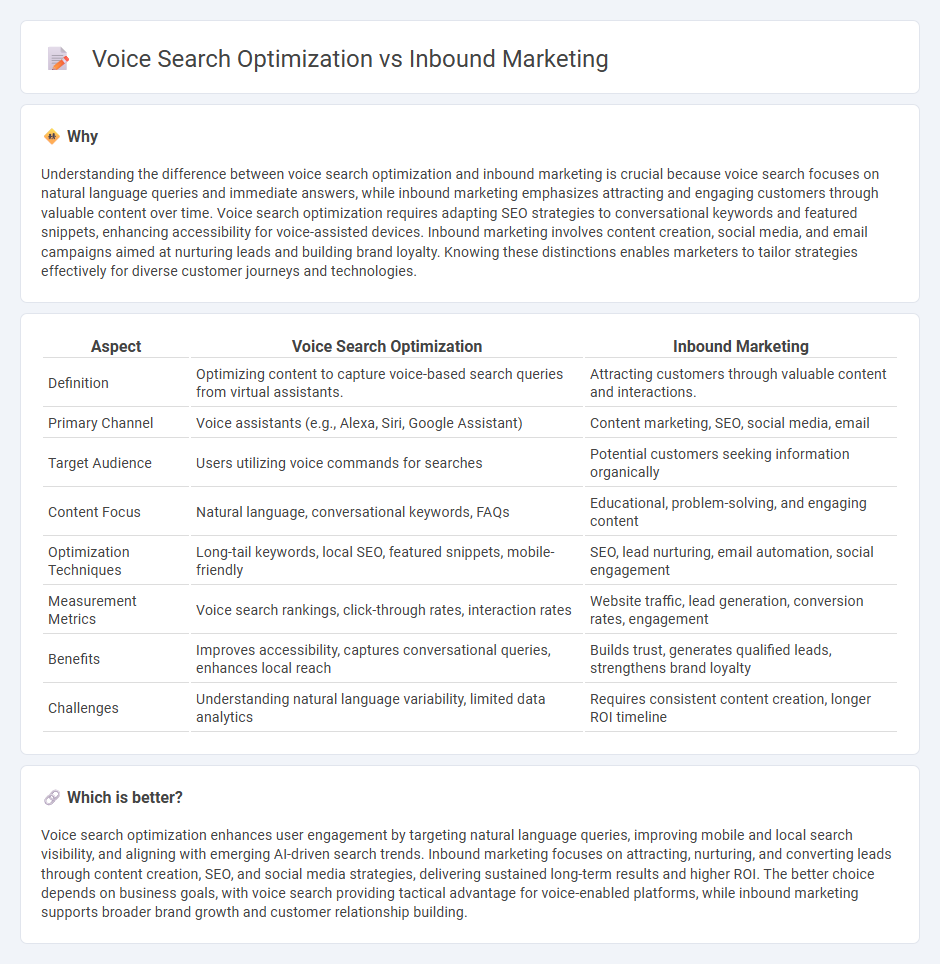
Voice search optimization leverages natural language processing and conversational keywords to enhance search engine visibility for voice-activated devices. Inbound marketing focuses on creating valuable content that attracts, engages, and nurtures potential customers through channels like blogs, social media, and email campaigns. Explore how combining these strategies can maximize your marketing impact.
Why it is important
Understanding the difference between voice search optimization and inbound marketing is crucial because voice search focuses on natural language queries and immediate answers, while inbound marketing emphasizes attracting and engaging customers through valuable content over time. Voice search optimization requires adapting SEO strategies to conversational keywords and featured snippets, enhancing accessibility for voice-assisted devices. Inbound marketing involves content creation, social media, and email campaigns aimed at nurturing leads and building brand loyalty. Knowing these distinctions enables marketers to tailor strategies effectively for diverse customer journeys and technologies.
Comparison Table
| Aspect | Voice Search Optimization | Inbound Marketing |
|---|---|---|
| Definition | Optimizing content to capture voice-based search queries from virtual assistants. | Attracting customers through valuable content and interactions. |
| Primary Channel | Voice assistants (e.g., Alexa, Siri, Google Assistant) | Content marketing, SEO, social media, email |
| Target Audience | Users utilizing voice commands for searches | Potential customers seeking information organically |
| Content Focus | Natural language, conversational keywords, FAQs | Educational, problem-solving, and engaging content |
| Optimization Techniques | Long-tail keywords, local SEO, featured snippets, mobile-friendly | SEO, lead nurturing, email automation, social engagement |
| Measurement Metrics | Voice search rankings, click-through rates, interaction rates | Website traffic, lead generation, conversion rates, engagement |
| Benefits | Improves accessibility, captures conversational queries, enhances local reach | Builds trust, generates qualified leads, strengthens brand loyalty |
| Challenges | Understanding natural language variability, limited data analytics | Requires consistent content creation, longer ROI timeline |
Which is better?
Voice search optimization enhances user engagement by targeting natural language queries, improving mobile and local search visibility, and aligning with emerging AI-driven search trends. Inbound marketing focuses on attracting, nurturing, and converting leads through content creation, SEO, and social media strategies, delivering sustained long-term results and higher ROI. The better choice depends on business goals, with voice search providing tactical advantage for voice-enabled platforms, while inbound marketing supports broader brand growth and customer relationship building.
Connection
Voice search optimization enhances inbound marketing by aligning content with natural language queries that users speak rather than type. Optimizing for voice search increases organic traffic through featured snippets and local search results, which are key components of inbound marketing strategies. Integrating voice search data into inbound campaigns enables more personalized and engaging customer experiences, driving higher conversion rates.
Key Terms
Content Creation
Inbound marketing leverages high-quality, relevant content to attract and engage target audiences organically, enhancing brand visibility through blogs, videos, and social media. Voice search optimization requires content to be tailored for natural language queries and conversational keywords, optimizing for smart assistants and voice-enabled devices. Explore advanced strategies in content creation to master both inbound marketing and voice search optimization effectively.
SEO (Search Engine Optimization)
Inbound marketing leverages content creation, social media engagement, and SEO strategies to attract and convert customers organically, while voice search optimization specifically targets natural language queries and conversational keywords to enhance visibility on voice-activated devices. Integrating voice search SEO within inbound marketing campaigns boosts search engine rankings, improves user experience, and captures the growing number of voice-assisted searches on platforms like Google Assistant, Alexa, and Siri. Explore effective techniques to blend inbound marketing with voice search optimization and elevate your SEO performance.
Conversational Keywords
Inbound marketing leverages content tailored to audience intent, while voice search optimization prioritizes conversational keywords that match natural speech patterns. Incorporating long-tail, question-based queries enhances visibility in voice search results, driving higher engagement and qualified traffic to your website. Explore how aligning inbound strategies with conversational keyword research can transform your digital marketing success.
Source and External Links
What Is Inbound Marketing? - HubSpot - Inbound marketing is a methodology that attracts loyal customers by aligning marketing efforts with the target audience's needs through valuable content.
What is inbound marketing? - Adobe Experience Cloud - Inbound marketing is a tactic to engage with consumers by creating content that they can find on their own, fostering trust and lasting relationships.
What is Inbound Marketing? Definition, Benefits & Trends - Inbound marketing involves attracting customers through relevant content across four stages: attract, engage, close, and delight.
 dowidth.com
dowidth.com